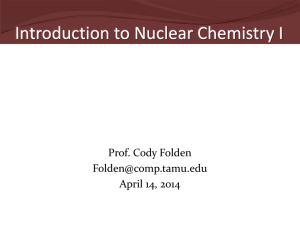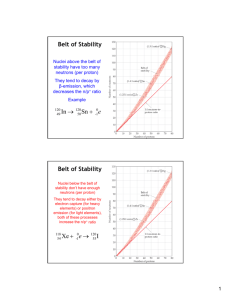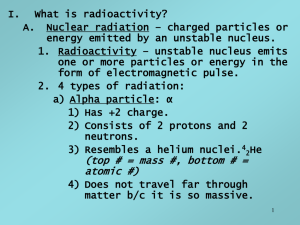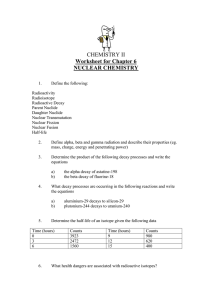Nuclear Chemistry (Topic for Regents exam, SAT II exam and AP exam)
advertisement
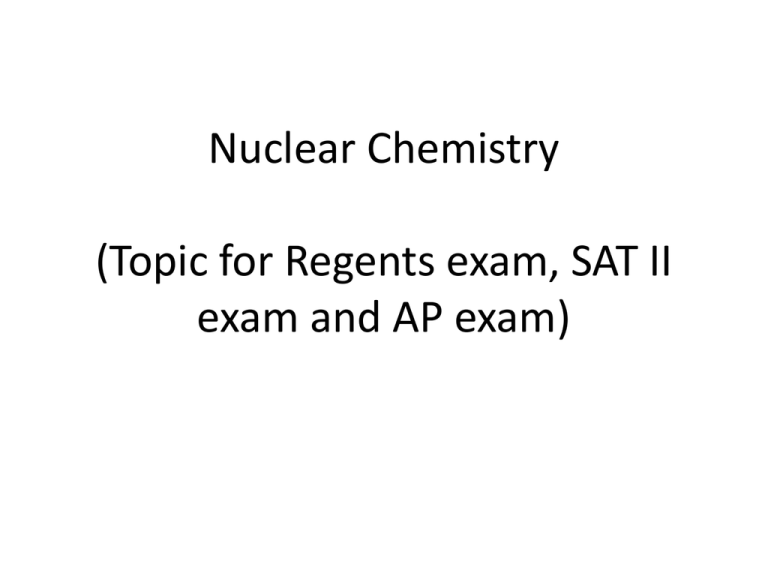
Nuclear Chemistry (Topic for Regents exam, SAT II exam and AP exam) Video Animations • Online resources from our TB for ch 21 (discovery: alpha, beta and gamma radiation) • Chem tours chapter 20 of Gilbert’s book see: http://www.wwnorton.com/college/chemistry /gilbert2/contents/ch20/chemtours.asp • Modes of radioactive decay, Balancing nuclear reactions and Fusion of Hydrogen The Nucleus • Remember that the nucleus is comprised of protons and neutrons. • The number of protons is the atomic number. • The number of protons and neutrons together is the mass of the atom. Isotopes • Not all atoms of the same element have the same mass due to different numbers of neutrons in those atoms. • There are three naturally occurring isotopes of uranium: – Uranium-234 – Uranium-235 – Uranium-238 Stable Nuclei • The shaded region in the fig. shows what nuclides would be stable, the socalled belt of stability. • It is the ratio of neutrons to protons that determines the stability of a given nucleus. Radioactivity • It is not uncommon for some nuclei to be unstable, or radioactive. • There are no stable nuclei with an atomic number greater than 83. • Radioisotopes = isotopes that are unstable and thus radioactive • There are several ways radionuclides can decay into a different nuclide • (a nuclide is a nucleus with a specified number of protons and neutrons (TB, p. 902) . Predicting the mode of radioactive decay. In general: •neutron-rich nuclei tend to emit beta particles •proton-rich nuclei tend to either emit positrons or undergo electron capture •heavy nuclei tend to emit alpha particles. •The presence of magic numbers of nucleons and an even number of protons and neutrons also help determine the stability of a nucleus. Radioactive Series • Large radioactive nuclei cannot stabilize by undergoing only one nuclear transformation. • They undergo a series of decays until they form a stable nuclide (often a nuclide of lead). • Transmutation = the reaction by which the atomic nucleus of one element is changed into the nucleus of a different element Types of Radioactive Decay Alpha Decay = Loss of an -particle (a helium nucleus) 4 2 238 92 U Atomic # decreases by 2 Mass # decreases by 4 # of protons decreases by 2 # of neutrons decreases by 2 He 234 90 4 2 Th + He Which element undergoes alpha decay to form lead-208? • Analyze • Plan • Solve • Check Types of Radioactive Decay Beta Decay = Loss of a -particle (a high energy electron) 0 −1 131 53 Atomic # increases by 1 # of protons increases by 1 # of neutrons decreases by 1 Mass # remains the same I 0 −1 or 131 54 e Xe + 0 −1 e Types of Radioactive Decay Positron Emission = Loss of a positron (a particle that has the same mass as but opposite charge than an electron) 0 1 11 6 Atomic # decreases by 1 # of protons decreases by 1 # of neutrons increases by 1 Mass # remains the same C e 11 5 B + 0 1 e Electron capture • Capture by the nucleus of an electron from the electron cloud surrounding the nucleus (effectively converts a proton to a neutron). • Ex: Rubidium-81 is converted to Krypton-81 by this process (Atomic numbers: Rb = 37, Kr = 36) • Nuclear equation: Types of Radioactive Decay Gamma Emission = Loss of a -ray (a photon of high-energy light that has no mass or charge & that almost always accompanies the loss of a nuclear particle; often not shown when writing nuclear equations) 0 0 Artificial Transmutation = done by bombarding the nucleus with high-energy particles (such as a neutron or alpha particle), causing transmutation 40 96 20Ca + _____ -----> 40 19K + 11H 2 H -----> 1 n + _____ Mo + 42 1 0 **Natural transmutation has a single nucleus undergoing change, while artificial transmutation will have two reactants (fast moving particle & target nuclei.** Nuclear Fission • Nuclear fission is the type of reaction carried out in nuclear reactors. • = splitting of large nuclei into middle weight nuclei and neutrons Nuclear Fission • Bombardment of the radioactive nuclide with a neutron starts the process. • Neutrons released in the transmutation strike other nuclei, causing their decay and the production of more neutrons. • This process continues in what we call a nuclear chain reaction. Nuclear Fusion • = the combining of light nuclei into a heavier nucleus • 2 1H + 21H 42He + energy • Two small, positively-charged nuclei smash together at high temperatures and pressures to form one larger nucleus. Half-Life = the time it takes for half of the atoms in a given sample of an element to decay - Each isotope has its own half-life; the more unstable, the shorter the half-life. - Table T Equations: fraction remaining = (1/2)(t/T) # of half-lives remaining = t/T Key: t = total time elapsed T = half-life Sample Half-Life Question 1A - Regents Most chromium atoms are stable, but Cr-51 is an unstable isotope with a half-life of 28 days. (a) What fraction of a sample of Cr-51 will remain after 168 days? Step 1: Determine how many half-lives elapse during 168 days. Step 2: Calculate the fraction remaining. Sample Half-Life Question 1B- Regents (Hint:1st use Regents tables to find half-life) (a) If a sample of Cr-51 has an original mass of 52.0g, what mass will remain after 168 days? Step 1: Calculate the mass remaining: mass remaining = fraction remaining X original mass (Note: Mass remaining can also be calculated by dividing the current mass by 2 at the end of each half-life.) Sample Half-Life Question 2- Regents How much was present originally in a sample of Cr-51 if 0.75g remains after 168 days? Step 1: Determine how many half-lives elapsed during 168 days. Step 2: Multiply the remaining amount by a factor of 2 for each half-life. Equations to learn for calculations based on half-life (AP) • Radioactive decay is a first order process; • ln (Nt/No) = -kt • Nt = No e-kt • k = 0.693/t1/2 • or t1/2 = 0.693/k • (kinetics topic) • k = ? (rate constant or decay constant) • N=? For time interval t Energy changes in Nuclear Reactions E =mc2 • Einstein E =mc2 • mass defect • For nuclear reactions ∆E =c2∆m • E = energy in Joules (J = kg•m2/s2) • m = mass in kg • C = speed of light • (2.9979 x 108 m/s) Activities and Problem set X TB ch. 21 – sections 21.1 and 21.4 most impt for AP exam POGIL activity on nuclear chemistry Lab activity: Paper lab on nuclear decay Concept map (Group) • Ch 21 Problems TO DO • all GIST, sample & practice exercises, Visualizing concepts, • Ch 21 end of ch. Red ex:21.7,9,11,13,15,19,23,2 5,27,29,31,33,41,43,45,57 ,65,70,
